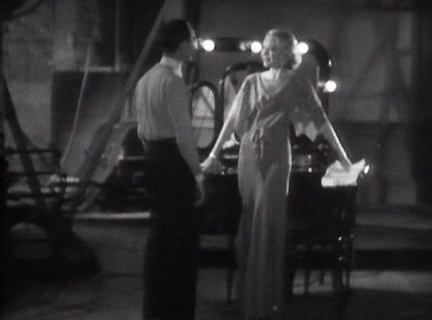George Cukor’s 1932 portrait of the rise, but not the fall of a young aspiring actress is best remembered as providing the working template for A Star is Born. Opening with its protagonist, Mary Evans, wistfully flipping through a celebrity gossip magazine, Cukor throws us into his world – Hollywood. But instead of another tired Hollywood exposé of the system that casually pokes fun at its own infrastructure, What Price Hollywood? presents something rare even in modern film. It’s a movie whose central relationship is that between a man and a woman, but one without any romantic connotation. Mary Evans’ relationship with Max Carey is friendship, but the film wisely doesn’t see that as a limitation, but instead an entirely new type of connection, one seldom represented in film.
Mary Evans is a waitress at a Hollywood restaurant. Seeing stars is not unusual for her or any of her coworkers, but she spots a golden opportunity when filmmaker Max Carey waltzes in one night. Max wakes up the next night with a tremendous hangover, which we soon discover is something of a trademark. He has no idea what happened the night before but Mary is laying on his couch. She tells him it was all rather wholesome, but that he promised her a spot in his next production. Not a problem, at first, but then it soon becomes apparent that Mary can’t exactly act. With her one seemingly washed away, she returns to her apartment exhausted but gets inspired. The next day she nails her scene, and her ascent begins just as Max’s alcoholism triggers his descent.
Cukor’s friendship-driven narrative naturally leads itself a queer reading. In one sequence, Max tries to show a distracted Mary how to properly seduce a man. I don’t think such a reading is forced, but I do think it is a little unhelpful here. While I find it’s a necessary viewpoint to consider throughout Cukor’s work, I think the personal thing here is the idea of platonic men-women relationships, which sounds so simplistic and unremarkable on paper but it plays out so beautifully, albeit tragically in Cukor’s hands. Mary does have a love interest, Lonny (who I’ll get to later) and while Lonny is a deplorable individual, his presence seems necessary to make us realize the value of Mary and Max’s friendship. With Lonny introduced, the film sets up an easy love triangle, one that would have been expected in 1932. Cukor wisely steers the movie away from this territory.
If there’s one particularly loud hiccup in Cukor’s visions, it is Lonny himself. He quite literally forces Mary on a date, by dragging her out of her bedroom. He later has to feed her. Such a setpiece is meant to be “charming” in the man’s persistence in his love interest. Again, it wouldn’t have been that unusual to see in a screwball comedy at the time. So how can I excuse Cukor for such a character? Well, I think the fact that he does come off so negatively is a conscious move. Mary and Lonny eventually end up together “happily” or at least we would read this from the final scene’s cinematic grammar. Lonny is such a reprehensible character, though, that it feels like an error to read this so easily.
Instead, I find Lonny’s presence and representation of romantic love for Mary to be emphasized as negative to contrast to the more positive friendship she has with Max. How often does cinema, like other forms of storytelling, emphasize the importance of finding “the one” or experiencing true love. Weirdly, this kind of grandiose sensation is one we’re suppose to both feel and try act out, which oddly enough leads to troubling and even abusive behaviors. Fittingly enough, it would not be a stretch at all to classify most of Lonny’s behavior in this film as abusive. A similar diagnosis could be made of most romantic relationships in Hollywood films at the time. The question becomes then if What Price Hollywood? romanticizes such a problematic dynamic or it attempts to deconstruct it? I think Cukor’s usual critical eye for Hollywood’s compulsory heterosexuality is present. Within this though, is a tribute to friendship. Again, it sounds corny, but how often have you seen a film about friendship that wasn’t just heterosexual men bonding? It is a vital image when other such relationships are represented, even more so when they’re cloaked in what appears to be a typical romantic situation.





Leave a comment